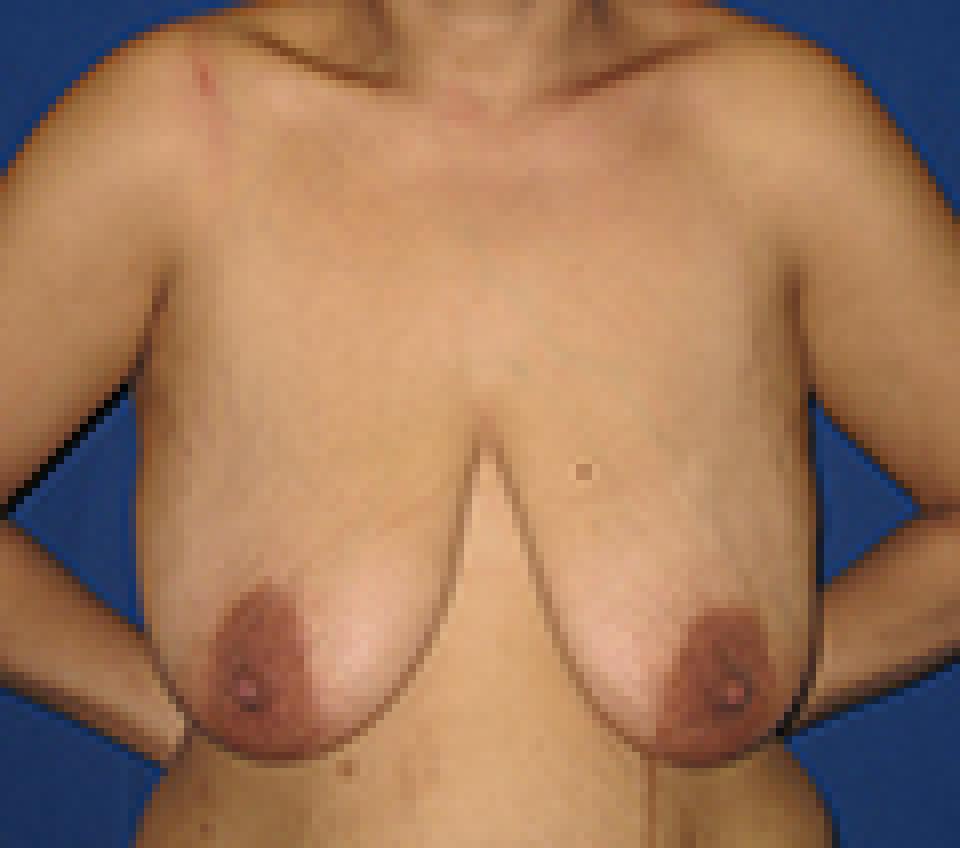Anchor Incision
The traditional ship’s anchor has a ring at the top, a shank, and a semicircular stock inferiorly – the “anchor” incision encircles the areola, is continued vertically down in the midline to the inframammary fold, and then by incising at the inframammary fold two flaps are developed with wide exposure of the underlying breast tissue.
It has the advantage of wide exposure permitting the removal of a substantial portion of tissue in breast reduction operations, as well as an opportunity to reduce the size of the areola should that be indicated.
It has the disadvantage that scars are caused by incisions and big scars are caused by big incisions. However since the scar is essentially below the nipple line, it will only be visible if the whole breast is exposed.
 before
before
 after
after
This case depicts a 41 year old woman who wished to have slightly smaller and shapelier breasts. She underwent breast reduction using an inverted T or "anchor" incision pattern.
Her post-operative photographs depict her appearance approximately two months after surgery.
With optimal design before surgery, the portion of this incision that runs along the fold of the breast is nearly completely hidden. Reduction of the areolar size for balance and proportion is an additional advantage of this procedure.
 before
before
 after
after
This 26 year old woman reached her plateau weight after losing 74 pounds following bariatric surgery. She had a breast lift or mastopexy using a technique which leaves behind scars in the shape of an “anchor.”
In some patients who lose a large amount of weight, the natural end point of the breast laterally disappears and the breast appears to continue around towards the back. This is what has happened to this woman.
In selected individuals who have this problem, the “anchor” scar type breast lift can be amended to remove that skin excess on the side of the body beneath the arm. This is the reason that I selected that particular breast lift technique in this woman even though the scars that it leaves behind are longer and more difficult to conceal in a swimsuit.
Looking at her photographs after surgery, it is obvious that there is no longer a "wing" of skin that continues laterally towards the back. Instead, the breast has a round shape and ends as it typically does before the side of the body that lies beneath the arm.
Unfortunately, there is now a visible scar there. This is an example of what I refer to as a “trade off” in plastic surgery. It is important to decide what is more important to each individual patient- a scar or better contour. Sometimes, it is not possible to have both!
 before
before
 after
after
This 39 year old woman underwent breast reduction in which approximately one and a half pounds of tissue was removed from each breast.
I view breast reduction as a two part process: first, tissue is removed to decrease the size and weight of the breasts; second, the remaining tissue is rearranged to create a new breast that has an aesthetically appropriate appearance. This rearranging process is very similar to what is done in a breast lift.
In this individual’s case, the incisions used to perform the breast reduction were of the “anchor” type and the incisions healed well.
Dr. Belsley's Philosophy of Breast Lift (Mastopexy)
In my practice, I perform breast lifts using incisions that result in a “lollipop” shaped scars. With good care and a bit of luck, these incisions heal well and the scars are difficult to see from a distance. Nevertheless, a woman who undergoes a cosmetic breast lift must be prepared for scars that are visible. This is one example of a “trade-off” in plastic surgery and of course, there are many others. This is one, however, that I feel is more than worthwhile in appropriate candidates.
More >>